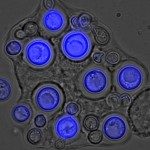Lien vers Pubmed [PMID] – 20375233
J. Clin. Microbiol. 2010 Jun;48(6):2043-6
The present study was performed to assess the interlaboratory reproducibility of the molecular detection and identification of species of Zygomycetes from formalin-fixed paraffin-embedded kidney and brain tissues obtained from experimentally infected mice. Animals were infected with one of five species (Rhizopus oryzae, Rhizopus microsporus, Lichtheimia corymbifera, Rhizomucor pusillus, and Mucor circinelloides). Samples with 1, 10, or 30 slide cuts of the tissues were prepared from each paraffin block, the sample identities were blinded for analysis, and the samples were mailed to each of seven laboratories for the assessment of sensitivity. A protocol describing the extraction method and the PCR amplification procedure was provided. The internal transcribed spacer 1 (ITS1) region was amplified by PCR with the fungal universal primers ITS1 and ITS2 and sequenced. As negative results were obtained for 93% of the tissue specimens infected by M. circinelloides, the data for this species were excluded from the analysis. Positive PCR results were obtained for 93% (52/56), 89% (50/56), and 27% (15/56) of the samples with 30, 10, and 1 slide cuts, respectively. There were minor differences, depending on the organ tissue, fungal species, and laboratory. Correct species identification was possible for 100% (30 cuts), 98% (10 cuts), and 93% (1 cut) of the cases. With the protocol used in the present study, the interlaboratory reproducibility of ITS sequencing for the identification of major Zygomycetes species from formalin-fixed paraffin-embedded tissues can reach 100%, when enough material is available.

